Table of Contents
- Understanding the Legacy of Spanish Horse Breeds
- The Majestic Andalusian: Spain’s Most Famous Export
- Paso Fino: The Smoothest Ride in Spanish Heritage
- Lusitano: The Warrior Horse of the Iberian Peninsula
- Spanish Mustang: Living Legacy of the American West
- Peruvian Paso: The National Horse of Peru with Spanish Roots
- The Rare and Hardy Florida Cracker Horse
- Galiceño: The Compact Spanish Beauty
- Essential Care and Training for Spanish Horse Breeds
- Choosing the Right Spanish Horse for Your Riding Level
- Modern Uses and Competitions for Spanish Horse Breeds
- The Future of Spanish Horse Breeds in Global Equestrian Sports
- Conclusion
- FAQ
Did you know that Spanish horse breeds have influenced over 70% of modern equine bloodlines worldwide? These magnificent Iberian horse breeds represent a remarkable legacy of Spanish equine heritage. They have captivated riders and horse enthusiasts for centuries.
Spanish horse characteristics are known for their exceptional versatility, intelligence, and elegant movements. From the majestic Andalusian to the compact Galiceño, these breeds have a rich history of horsemanship. They span continents and cultures.
The Spanish horse history is a remarkable journey of genetic excellence and cultural significance. These horses have played crucial roles in warfare, transportation, and modern equestrian sports. They are some of the most respected breeds globally.
Key Takeaways
- Spanish horse breeds have global genetic influence
- Exceptional versatility across riding disciplines
- Rich cultural and historical background
- Superior intelligence and trainability
- Elegant and distinctive physical characteristics
- Adaptable to various riding skill levels
Understanding the Legacy of Spanish Horse Breeds
The history of Spanish horse breeds is a story of cultural exchange, military might, and top-notch breeding. These horses changed how European royalty saw them.

For centuries, Spanish horse breeding has shown the mix of different cultures and their horse breeding ways.
The Moorish Influence on Spanish Equine Development
The Moors changed horse breeding in Spain when they took over. They brought in new bloodlines and better breeding methods. This made Spanish horses even better.
- Introduction of Arabian and Berber horse genetics
- Refinement of selective breeding methods
- Development of more resilient and agile horse breeds
Impact on Modern Horse Breeding Worldwide
Spanish horse breeds have shaped horse genetics globally. Their great qualities have spread everywhere, from Europe to the Americas.
| Horse Breed | Global Influence | Key Characteristics |
|---|---|---|
| Andalusian | European Cavalry | Strength, Elegance |
| Lusitano | Dressage Breeding | Agility, Intelligence |
Historical Significance in European Cavalry
European royalty loved Spanish horses for their military skills. These horses were more than just a ride; they were key in battles, showing great bravery and flexibility.
“A Spanish horse is not just an animal, but a living testament to centuries of breeding excellence.” – Equine Historian
Today, Spanish horse breeds still inspire horse lovers. They show a deep link between culture and amazing animal breeding.
The Majestic Andalusian: Spain’s Most Famous Export

The Andalusian horse is a symbol of Spanish excellence, known for its grace, strength, and smarts. It comes from the Iberian Peninsula. This breed has won the hearts of many with its beauty and skills.
Andalusian horses stand out for their muscular build and elegant moves. They are top performers in dressage, showing off their agility and precision.
- Pure white or gray coat colors dominate the breed
- Average height ranges between 15-16.2 hands
- Exceptional intelligence and trainability
- Renowned for smooth, elevated gaits
“The Andalusian horse is not just a breed, but a living piece of Spanish cultural heritage.” – Equestrian Monthly
Andalusian horses have a rich history, serving in royal courts and military battles. Their noble nature and skills made them highly valued by nobles and riders.
| Characteristic | Description |
|---|---|
| Origin | Andalusia, Spain |
| Primary Use | Dressage, Classical Riding |
| Temperament | Intelligent, Gentle, Responsive |
| Unique Traits | Elevated Movements, Strong Muscular Structure |
Today, Andalusian horses lead in international dressage, showing their lasting impact. Their natural talent in complex movements makes them unmatched in classical riding.
Paso Fino: The Smoothest Ride in Spanish Heritage
The Paso Fino is a top choice among Spanish horse breeds. It’s known for its smooth four-beat gait that wins hearts around the world. Hailing from Colombia and Puerto Rico, this horse is a symbol of elegance and comfort.
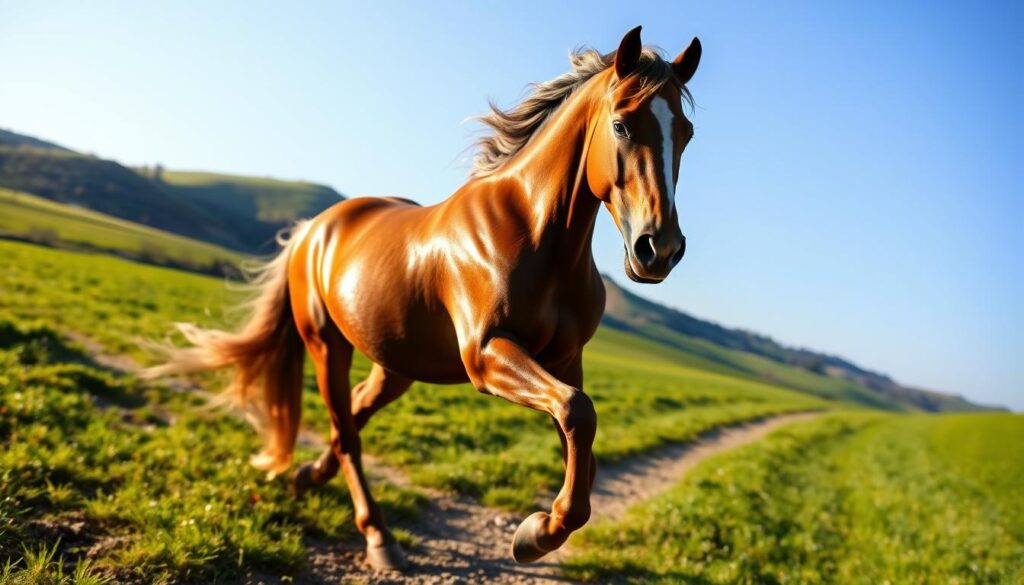
Coming from Spanish Colonial horses, the Paso Fino shows off centuries of horse training. Its unique gait makes it stand out, offering a ride like floating on air.
Understanding the Unique Four-Beat Gait
The Paso Fino’s smooth four-beat gait is a wonder of horse mechanics. This lateral ambling movement has:
- Extraordinary rider comfort
- Minimal ground impact
- Exceptional energy efficiency
- Precise, rhythmic leg movements
Training Methods for Perfect Paso Form
Training a Paso Fino needs special methods that focus on natural movement. Expert trainers work on:
- Developing natural lateral movement
- Reinforcing rhythmic leg patterns
- Building muscular strength
- Encouraging fluid, controlled motion
Competition and Show Standards
| Competition Category | Judging Criteria | Key Evaluation Points |
|---|---|---|
| Classic Fino | Precision of Movement | Minimal ground contact |
| Paso Corto | Intermediate Gait | Balanced rhythm |
| Paso Largo | Extended Speed | Controlled acceleration |
“The Paso Fino doesn’t just walk—it dances with the ground.” – Equestrian Quarterly
Riders and fans are amazed by the Paso Fino’s ability to offer a super-smooth ride. It’s a cherished part of Spanish horse heritage.
Lusitano: The Warrior Horse of the Iberian Peninsula

The Lusitano horse is a symbol of Portugal’s rich horse culture. It comes from the Iberian Peninsula. This breed has changed from a legendary war horse to a star in modern horse sports.
Lusitano horses are known for their amazing skills. They do well in many areas. Their talents are especially seen in:
- Dressage competitions
- Precise jumping techniques
- Elegant driving performances
- Traditional Portuguese bullfighting
The Lusitano is known for its beauty and strength. They are 15-16 hands tall. Their muscles show their warrior past. Their smart eyes and curved neck make them stand out.
“The Lusitano is not just a horse, but a living testament to centuries of equestrian tradition.” – Portuguese Horse Breeding Association
Studies show the Lusitano is closely related to the Andalusian horse. They share a long history of horse breeding. They are calm but full of spirit. This makes them great for both pros and hobbyists.
| Characteristic | Lusitano Details |
|---|---|
| Average Height | 15-16 hands |
| Primary Colors | Gray, bay, black |
| Special Skills | Dressage, classical riding |
Today, the Lusitano is loved worldwide in horse sports. It’s known for its amazing skills and genetics. Their ability to do many things makes them a favorite among horse lovers.
Spanish Mustang: Living Legacy of the American West
The Spanish Mustang is a true marvel of equine strength and history. These horses come from the Spanish conquistadors’ horses brought to North America. They show the spirit of the American West.

These horses are a genetic treasure, surviving tough times for centuries. Groups work hard to keep their breed alive. They focus on keeping their genetic makeup pure.
Conservation Efforts and Breeding Programs
Keeping the Spanish Mustang alive needs careful breeding. This ensures their genetic diversity and purity. Key efforts include:
- Creating safe herds in western states
- Tracking their genetics
- Setting up special breeding registries
- Supporting wild horse sanctuaries
Natural Horsemanship Techniques
Natural horsemanship is perfect for Spanish Mustangs. It respects their smart and independent nature. Trainers build trust with gentle, consistent communication.
“The Spanish Mustang embodies the true spirit of partnership between horse and human.” – Wild Horse Preservation Network
Adaptability in Various Terrains
The Spanish Mustang is incredibly adaptable. Their small size and strong hooves let them easily move through different landscapes.
| Terrain Type | Adaptation Level | Performance Rating |
|---|---|---|
| Mountain Trails | Excellent | 9/10 |
| Desert Regions | Superior | 10/10 |
| Forest Paths | Very Good | 8/10 |
These horses amaze people with their history and amazing abilities. They connect us to the American West’s rich horse heritage.
Peruvian Paso: The National Horse of Peru with Spanish Roots

The Peruvian Paso is a stunning example of Spanish horse breeds. It’s known for its elegance and smooth movement. As Peru’s national horse, it wins the hearts of horse lovers everywhere with its special traits and deep cultural roots.
This breed comes from Spanish bloodlines and has a unique smooth gait. Its paso llano gait makes riding incredibly comfortable. It’s like floating on a cloud.
“The Peruvian Paso moves with such grace that it seems to glide across the ground without effort.” – Peruvian Equestrian Association
- Distinctive four-beat lateral gait
- Direct descendant of Spanish horse breeds
- Recognized as Peru’s national horse since 1992
- Renowned for exceptional smoothness and comfort
The Peruvian Paso is a medium-sized horse with a strong build and elegant stance. They are usually 14-15.2 hands high. Their coats come in various colors like bay, black, chestnut, and gray, showing their genetic diversity.
People love the Peruvian Paso for its calm nature and long-lasting stamina. They’re perfect for casual rides, traditional shows, or competitions. This breed is a favorite among horse enthusiasts worldwide.
The Rare and Hardy Florida Cracker Horse
The Florida Cracker Horse is a true marvel of Spanish colonial horse breeds in the United States. It thrived in Florida’s tough landscapes, gaining traits crucial for early cattle ranchers.
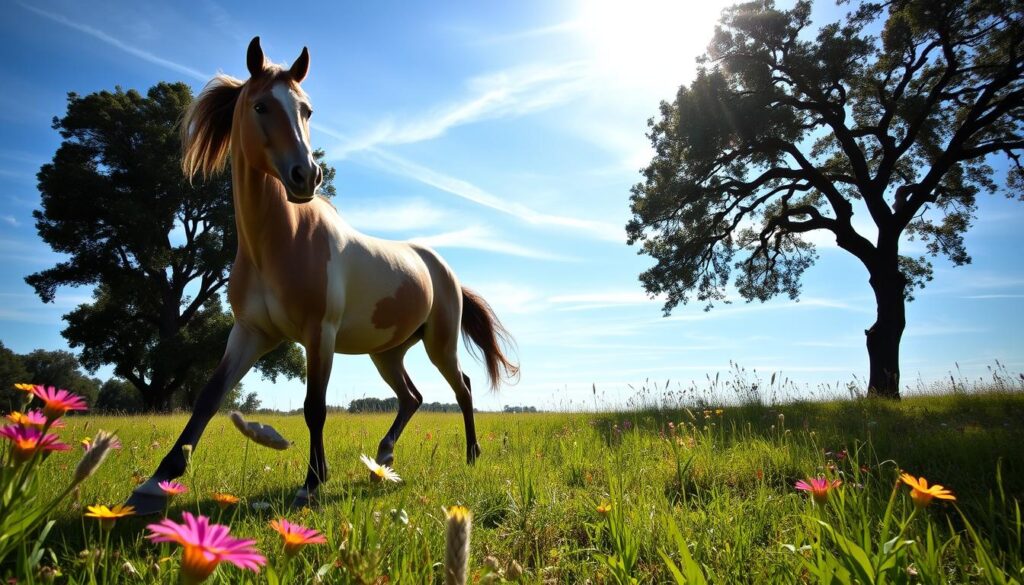
Historical Role in American Cattle Herding
In Florida’s early cattle days, the Florida Cracker Horse was a key player in herding. Its agility was perfect for the state’s tough terrain. It worked with cowboys to manage huge herds across swamps and grasslands.
- Developed exceptional maneuverability in rough terrain
- Highly intelligent and responsive to cattle herding techniques
- Weight typically ranges between 700-900 pounds
- Average height of 13.5 to 15 hands
Modern Conservation Status
The Florida Cracker Horse was close to extinction in the mid-20th century. Thanks to breed lovers and conservation efforts, it’s now saved and its genetic diversity is protected.
| Conservation Metric | Current Status |
|---|---|
| Registered Horses | Approximately 1,000 |
| Breeding Programs | Active state-sponsored conservation efforts |
| Genetic Diversity | Carefully managed bloodlines |
Breeding Standards and Characteristics
Today’s Florida Cracker Horses still show their hardiness and versatility. They meet breed standards for natural athletic ability, sound body, and the traits that made them vital to Florida’s ranching history.
“The Florida Cracker Horse represents a living connection to our state’s agricultural heritage” – Florida Horse Council
These horses are still valued for their smarts, stamina, and historical importance. They link Florida’s ranching past to its lively equestrian scene today.
Galiceño: The Compact Spanish Beauty
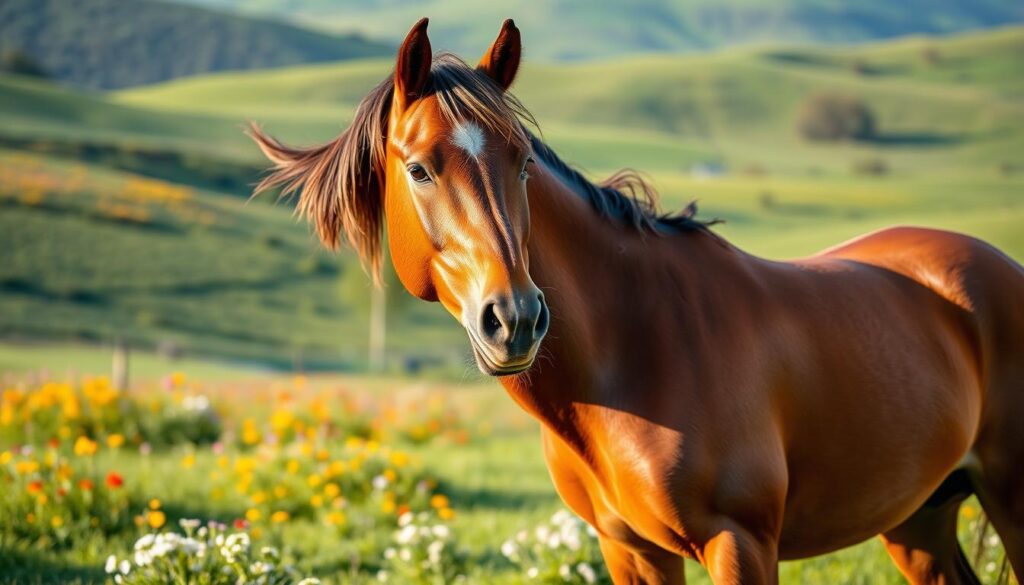
The Galiceño horse is a rare gem among Spanish horse breeds. It is known for its small size and versatility. Coming from the Galicia region of Spain, this horse has made a unique mark in the world of horses.
Standing between 13 and 14 hands high, the Galiceño is strong despite its small size. Its sturdy build makes it perfect for riders looking for a reliable and agile horse.
- Breed Origin: Galicia, Spain
- Average Height: 13-14 hands
- Primary Characteristics: Compact build, strong constitution
- Known For: Exceptional versatility
Studies show the Galiceño was bred for endurance, intelligence, and smooth gaits. They moved to Mexico and then the United States, bringing new bloodlines while keeping their core traits.
“The Galiceño is proof that great things come in small packages” – Anonymous Horse Breeder
Today, people love the Galiceño for its gentle nature and hard work ethic. They are great for leisure rides, ranch work, or training young riders.
Their small size is perfect for younger riders or smaller adults. The breed’s Spanish roots give it elegant movement and smartness, making it stand out.
Essential Care and Training for Spanish Horse Breeds
Spanish horse breeds are unique and need special care and training. Knowing their needs helps keep them healthy and performing well.
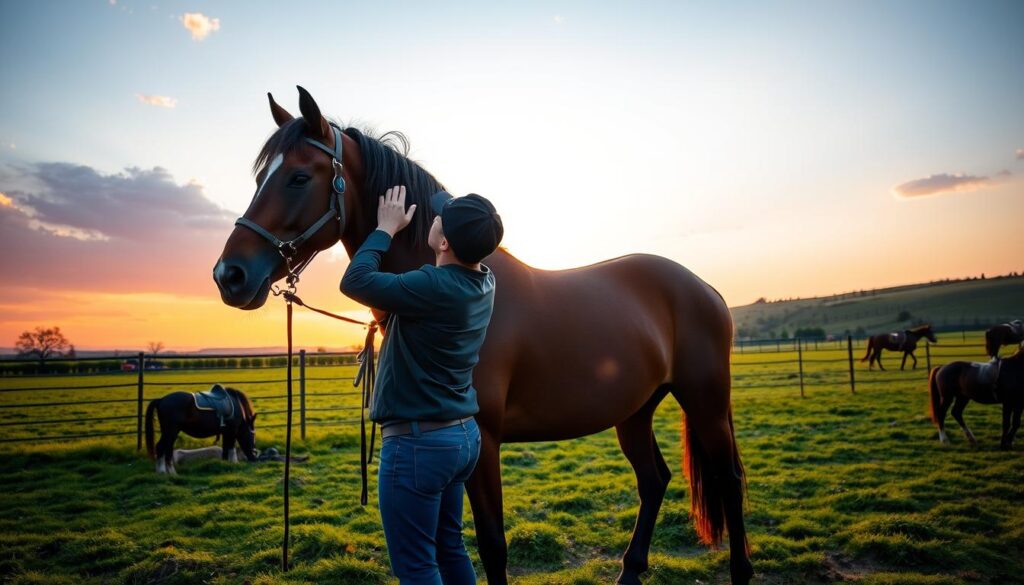
These horses need a full care plan. This includes the right food, exercise, and health checks.
Nutrition Requirements for Spanish Horses
Good nutrition is key for Spanish horses. They have special needs because of their metabolism.
- High-quality hay with balanced protein content
- Mineral supplements specific to breed requirements
- Controlled grain intake to prevent weight issues
Exercise and Conditioning
Training for Spanish horses keeps them athletic and moves well.
- Daily cardiovascular exercises
- Strength training routines
- Flexibility and agility drills
Health Monitoring Tips
Keeping an eye on health is vital for Spanish horses.
| Health Aspect | Monitoring Frequency | Key Considerations |
|---|---|---|
| Dental Check-ups | Biannual | Specialized equine dentistry |
| Hoof Care | Every 6-8 weeks | Regular trimming and balanced shoeing |
| Veterinary Examinations | Annually | Comprehensive health screenings |
“Dedicated care transforms a good horse into an extraordinary companion.” – Equine Expert
Grooming is important for Spanish horses. Regular brushing and baths keep them healthy and strong. It also strengthens the bond between horse and rider.
Choosing the Right Spanish Horse for Your Riding Level
Finding the right Spanish horse breed is all about knowing your riding level and goals. Each breed has its own special traits. These traits fit different rider skills and riding styles.
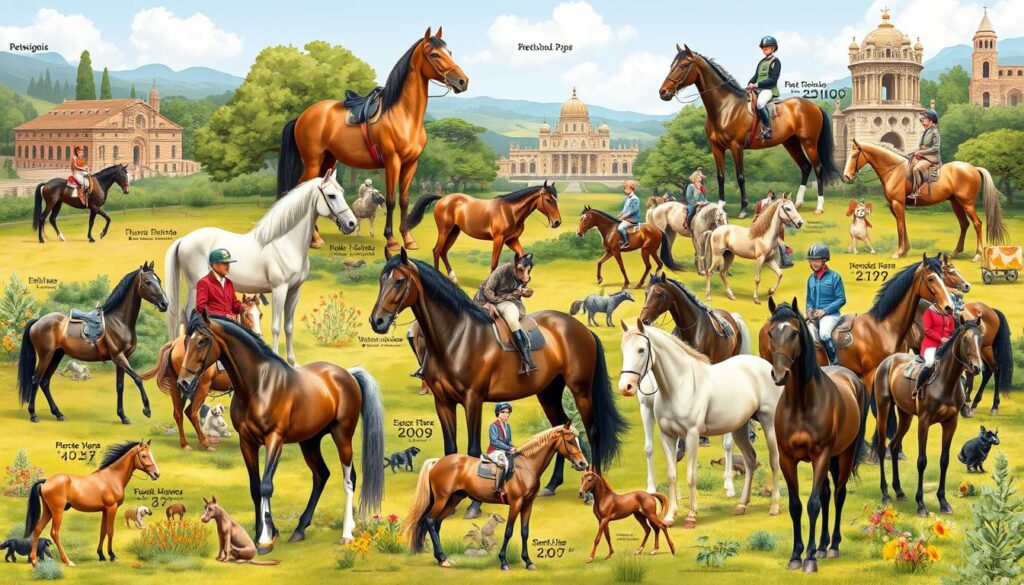
When looking at Spanish horse breeds, there are key things to think about:
- Personal riding experience
- Intended riding discipline
- Physical fitness
- Training commitment
Your riding experience affects how well you and the horse will work together. Beginners might like the calm Andalusian. More experienced riders might prefer the lively Lusitano.
“Matching your skills with the right horse’s temperament is key to a successful partnership.” – Professional Equestrian Trainer
Here are some breed suggestions based on your riding level:
| Rider Level | Recommended Spanish Horse Breed | Key Characteristics |
|---|---|---|
| Beginner | Andalusian | Gentle, trainable, patient temperament |
| Intermediate | Paso Fino | Smooth gait, responsive training |
| Advanced | Lusitano | High energy, complex training requirements |
Remember, each horse is unique, even within breeds. Always talk to experts and spend time with horses before choosing.
Modern Uses and Competitions for Spanish Horse Breeds
Spanish horse breeds have become stars in equestrian sports around the world. They are known for their elegance and skill in dressage, jumping, and driving. This makes them top performers in competitions everywhere.
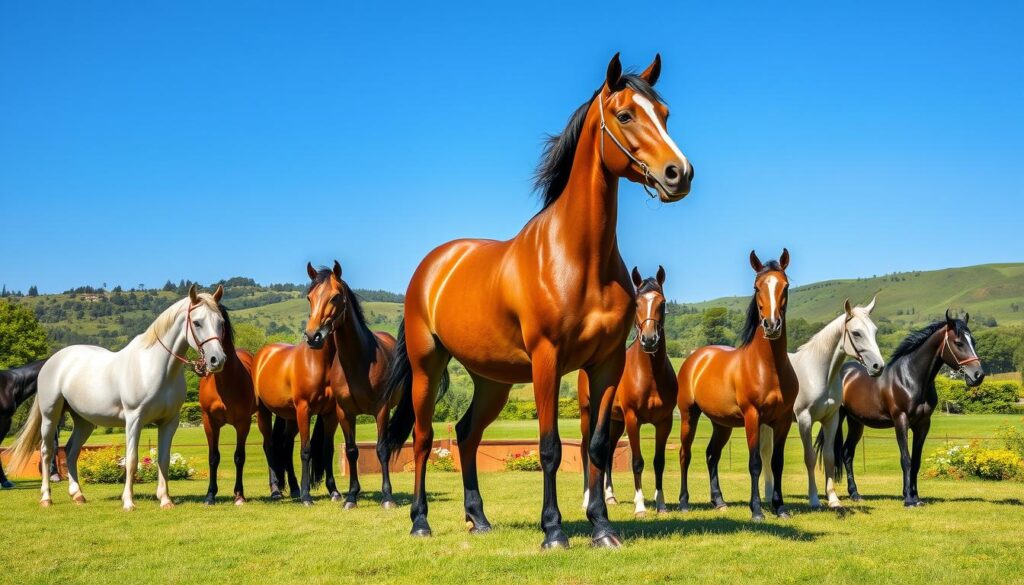
- Classical Dressage Championships
- International Show Jumping Events
- Driving Competitions
- Western Riding Exhibitions
The Andalusian and Lusitano breeds excel in classical dressage. Their elegant movements and precision impress judges. They are truly exceptional in Spanish horse riding disciplines.
“Spanish horses represent the pinnacle of equine elegance and athletic performance.” – International Equestrian Magazine
Professional riders love these breeds for their smarts, quickness, and ability to adapt. They shine in many different competitions.
| Horse Breed | Primary Competition Strengths | Notable Achievements |
|---|---|---|
| Andalusian | Dressage | Multiple World Championship Titles |
| Lusitano | Classical Riding | International Performance Awards |
| Spanish Mustang | Western Disciplines | Endurance and Versatility Competitions |
These amazing horses also wow people in movies, cultural events, and riding shows. They show their timeless beauty and unmatched talent.
The Future of Spanish Horse Breeds in Global Equestrian Sports
The world of Spanish horse breeds is changing fast. Breeding programs and conservation efforts are leading this change in equestrian sports. These horses are getting a new life, mixing old traditions with new breeding methods.
- Advanced genetic tracking for better breeding choices
- More recognition in international dressage competitions
- Higher need for special equestrian training
- New tech in horse care and performance
Efforts to save these breeds are crucial. Groups all over the world are working hard. They aim to keep the genetic diversity and special traits of Spanish horses.
| Breed | Global Popularity | Conservation Status |
|---|---|---|
| Andalusian | High | Active Preservation |
| Lusitano | Growing | Monitored |
| Spanish Mustang | Moderate | Critical |
“The future of Spanish horse breeds lies in balancing traditional excellence with innovative breeding strategies.” – International Equestrian Association
New tech is changing equestrian sports, with Spanish horses leading the way. These horses are at the center of new breeding, training, and market trends. This creates new chances for them.
The dedication to saving and celebrating Spanish horse breeds is key. It ensures they stay important in equestrian culture worldwide. This promises a bright future of excellence and cultural preservation.
Conclusion
Spanish horse breeds are a perfect mix of equestrian heritage and unmatched versatility. From the elegant Andalusian to the compact Galiceño, these horses have won the hearts of riders for generations. Their long history shows how adaptable they are, making them great friends for riders of all levels.
Exploring Spanish horse breeds is more than just seeing beautiful animals. These horses connect us to cultural traditions, from Europe’s battlefields to the American West’s ranches. Their smooth gaits, intelligence, and trainability make them stand out worldwide.
To keep these breeds alive, we need to work hard on conservation, breeding, and education. Riders looking to experience Spanish horse breeds will find a world full of possibilities. Whether you want a competitive partner, a trail friend, or a link to history, these horses offer an unforgettable ride.
As we delve into the world of Spanish horse breeds, we discover a deep genetic legacy that inspires and amazes. The tale of these horses is still being written – a story of strength, beauty, and adaptability.
FAQ
What makes Spanish horse breeds unique?
Spanish horse breeds stand out for their elegant movements and strong builds. They have smooth gaits and are very intelligent. These horses have a rich history, tracing back to Moorish and European royal lines. They excel in many areas, like dressage, driving, and cattle work.
Are Spanish horse breeds suitable for beginners?
Yes, breeds like the Andalusian and Paso Fino are great for new riders. They are calm and have smooth gaits. But, remember, each horse is different, and training is key. Some breeds, like the Lusitano, might need more experienced riders because of their high energy.
How expensive are Spanish horse breeds?
Prices for Spanish horse breeds vary from $5,000 to $100,000. This depends on the horse’s lineage, training, age, and rarity. For example, purebred Andalusians and Lusitanos with top bloodlines can be very pricey. The horse’s competition history, training level, and unique qualities also affect the price.
What is the most famous Spanish horse breed?
The Andalusian is the most famous Spanish horse breed. It’s known for its striking white or gray coat and powerful build. They are celebrated for their performance in dressage and have been favored by European royalty for centuries.
Do Spanish horse breeds require special care?
Yes, they need special care. They require the right nutrition, regular exercise, and grooming. They also need consistent training to stay in top shape. Regular vet visits and health checks are important for these breeds.
What horse disciplines are Spanish breeds best suited for?
Spanish breeds are great for many disciplines. They excel in dressage, jumping, driving, trail riding, and cattle work. The Lusitano is famous for dressage, while the Paso Fino is known for its smooth gait. The Spanish Mustang is perfect for endurance and trail riding.
Are there any rare Spanish horse breeds?
Yes, there are rare breeds like the Galiceño and the Florida Cracker Horse. These breeds have small populations. Efforts are being made to save these unique and historically important horses.
How long do Spanish horse breeds typically live?
On average, Spanish horse breeds live 25-30 years with proper care. Their lifespan depends on genetics, nutrition, exercise, and vet care. Some horses can live into their mid-30s with the right care.
